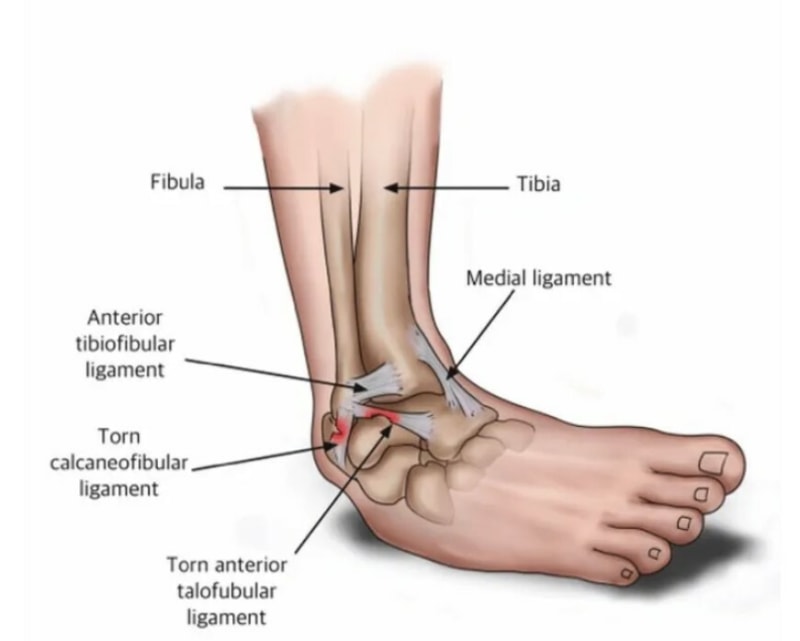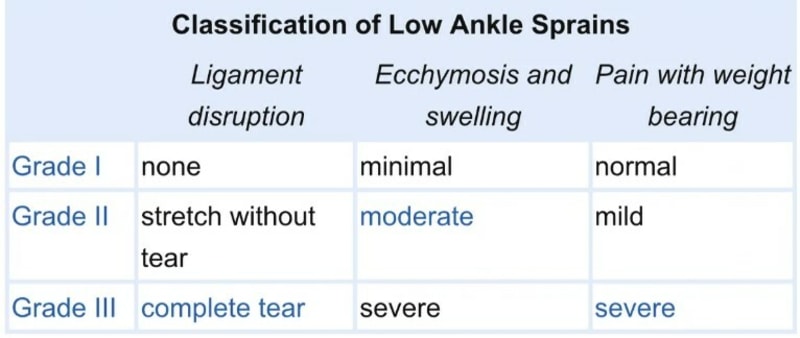
'Lateral' Ankle Sprain - Don't Just "Walk it Off"
November 26, 2019
The basketball player that comes down from a rebound and lands on his teammate’s foot, the tennis player that rolls her ankle reaching to return a serve, the pedestrian that steps off the curb just the wrong way...if you have not experienced an ankle sprain yourself, chances are, you know someone who has. It is highly likely that you or the person you know has sustained a ‘lateral’ ankle sprain. While ankle sprains, in general, are highly prevalent among lower extremity injuries--a ‘lateral’ ankle sprain is the most common reason for missed athletic participation.(1)
What is a ‘lateral’ ankle sprain? First, let’s talk about anatomy: a ligament connects bone to bone. Ligament injuries are categorized as “sprains” while muscle/tendon injuries are classified as “strains.” There are three ligaments that provide stability on the outside of the ankle joint. These ligaments are the anterior talofibular ligament (ATFL), calcaneofibular ligament (CFL), and the posterior talofibular ligament (PTFL). A lateral ankle sprain occurs when the foot rolls inward and ankle joint rolls outward, resulting in injury to one or all of these ligaments.

Photo Credit: https://www.bodywisemyotherapyandpilates.com/post/pain-profile-lateral-ankle-sprain (2)
‘Lateral’ ankle injuries are often classified as grade I, II, or III sprains. The grade of the ankle sprain depends on the amount of ligament disruption, the presence of bruising and swelling, and pain with weight-bearing.(1)

Photo Credit: https://www.orthobullets.com/foot-and-ankle/7028/ankle-sprain (1)
What do I do if I sprain my ankle? Seek a healthcare provider for an appropriate diagnosis. It is also important to seek help as soon as possible if the pain is severe in order to rule out the presence of a fracture. Getting an appropriate diagnosis will help to best guide the treatment of your ankle sprain. For example, the rehab of a grade III lateral ankle sprain is much more conservative than for a grade I sprain. A grade III sprain may require the use of a walking boot or crutches early on; whereas, you may require no assistive device for walking after a grade I lateral ankle sprain.
What is “RICE?” Most ankle injuries require a period of “RICE” during the acute phase of healing. RICE stands for: rest, ice, compression, elevation. In other words, get off your feet, elevate your ankle above your heart, apply ice for 10-15 minutes, and utilize a compression sleeve or an ace wrap to help control the swelling.
What happens after the acute phase of injury? Talk to your doctor about seeing a physical therapist in order to reduce your symptoms and to improve your overall physical function. Seeing a physical therapist can prove to be very valuable after sustaining an ankle sprain. In one study, 74% of individuals exhibited at least one residual symptom of either pain, swelling, weakness, or instability as long as 1-4 years after injury. (3) Physical therapy can help reduce the incidence of these residual symptoms and can aid in the restoration of normal ankle function.
Did you know that lateral ankle sprains have the highest re-injury rate of all lower extremity musculoskeletal injuries? (3) These repeated ankle sprains can lead to Chronic Ankle Instability (CAI) as well as other bony and cartilaginous changes which can further lead to ankle osteoarthritis (OA), decreased participation in recreational activities, and a lower quality of life. (3,4) Seeing a physical therapist can also help reduce the recurrence of ankle sprains. This is mostly accomplished through patient education and a solid home program for you to continue once formal physical therapy is complete.
What if I don’t have the time or finances to go to physical therapy? Some individuals are resistant to attend physical therapy due to potential strain on time and finances. If untreated in the long term, ‘lateral’ ankle sprains can actually be associated with higher societal economic costs due to the price of multiple interventions (imaging, multiple visits to the doctor, surgery) and time missed from work. (3) The good news is that physical therapists can develop a plan of care and an effective home program that best suits your financial and physical needs. You may only need a few visits to establish a solid home program and progress your exercises until you have reached your long term fitness and/or sports goals. More good news, compliance with a quality home program can help prevent re-injury. Huppert's et al investigated the effectiveness of a home-based proprioceptive training program to prevent ankle sprain recurrence. The risk of recurrence per 1000 hours of exposure for the intervention group was significantly lower as compared to the control group. (5)
When can I return to my regular fitness routine or sport? Most athletes return to sport 3-21 days after a mild ‘lateral’ ankle sprain. (6) This time frame depends on the amount of ligament disruption, presence of associated injuries, and compliance with rehab.(1) As mentioned before, it is important to see and discuss a return to sport decision with your medical team. Your medical team may consist of a physician, athletic trainer, and/or a physical therapist who will ensure that you progress through an appropriate rehabilitation program including, but not limited to: mobility/flexibility exercises, strengthening, balance/proprioception training, sport-simulated activities, and return to sport/functional testing.
Next time you sprain your ankle, do not just limp around and "walk it off" expecting it to get better. Talk to your trusted healthcare provider and get a proper diagnosis. Begin physical therapy to reduce pain, improve strength/balance deficits, and prevent re-injury. If you are a high school or college athlete talk to your athletic trainer about what you can do to best rehabilitate your ankle.
Want to know more about preventing ankle injuries or rehabilitation after ankle injury? Stay tuned for more information on our blog and follow us on Instagram for more updates, blog posts, and rehabilitation videos.
More questions? Contact us directly via email at [email protected] or phone at 254098060 to set up a free 15-minute consultation to see if you are a candidate for physical therapy.
References:
- https://www.orthobullets.com/foot-and-ankle/7028/ankle-sprain
- https://www.bodywisemyotherapyandpilates.com/post/pain-profile-lateral-ankle-sprain
- Delahunt E, Bleakley CM, Bossard DS, et al. Clinical assessment of acute lateral ankle sprain injuries (ROAST): 2019 consensus statement and recommendations of the International Ankle Consortium. British Journal of Sports Medicine 2018;52:1304-1310
- Hayman J, Prasd S, Stulberg D. Help Patients Prevent Repeat Ankle Injury. The Journal of Family Practice. 2010. 59(1):32-34
- Thompson J, Byrne C, Williams M, Keene D, Schlussel M, Lamb S. Prognostic Factors for Recovery Following Acute Lateral Ankle Ligament Sprain: A Systematic Review.
- Wells B, Allen C, Deyle G, Croy T. Management of Acute Grade II Lateral Ankle Sprains With an Emphasis on Ligament Protection: A Descriptive Case Series. International Journal of Sports Physical Therapy 2019; 14(3):445-458.

